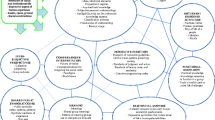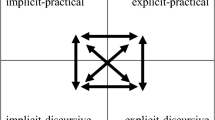Abstract
In cultural sociology, the concept of culture refers to processes and products of meaning-making. This concept sustains coherence while also encompassing empirical complexity and theoretical difference. Much of the variety in the way cultural sociologists talk about culture is simply attributable to inconsequential terminological difference, and the remainder is attributable to differences of empirical angle and theoretical emphasis within the field which are encompassed by this core idea. Cultural sociologists understand meaning as transcending biology, irreducible to social structure, and public rather than private. These conceptual boundaries provide a firm foundation for empirical research and guide the development of cultural theory. Further exploration of the concept of “meaning” is better pursued in the analytic philosophy of meaning, but such exploration is unnecessary and potentially counter-productive for cultural sociology.
Similar content being viewed by others
Notes
Ghaziani (2009) cites Fine (1979) for this phrase: as is a common rhetorical tactic, both authors touch on this issue in an attempt to enhance the proposed value of their own contributions. However, the “amorphous mist” metaphor seems particularly clumsy considering just how analytical and precise humans can be about “amorphous mist” – as we can see at any time by visiting a National Weather Service site.
However, it is important to note that many if not most cultural sociologists explicitly positioned themselves against postmodern theory when its influence was widespread in the late eighties and nineties. Many of us valued the emergence of cultural sociology as a more empirically rigorous way of investigating phenomena like cultural diversity and cultural power that postmodernism only alluded to (e.g. Schudson 1997; Spillman 1997, 141–42).That more sociological sensibility has not changed.
Smith grounds his belief in “coherence-in-complexity” and the scholarly discipline of seeking understanding in critical realism. I am not particularly committed to critical realism, though neither am I particularly opposed. But I think these presuppositions are essential for any commitment to scholarship, and it is not clear to me any thoughtful scholar could oppose them, even self-conscious positivists.
Moreover, Smith sometimes draws on excerpts in the anthology I edited (Spillman 2002), where authors are not quoted in their entirety but in selections of five thousand words. I deliberately edited out more abstract theoretical and methodological discussions, keeping in mind a target audience of students, so these excerpts cannot be used as a basis for assessing authors’ general views of culture.
Early in graduate school, I was puzzled by the abundance of cultural theory in anthropology, compared to its relative absence in sociology of the time. As Smith did later, I submitted myself to the ritual hazing of aspiring cultural theorists presented by reading Kroeber and Kluckhohn’s (1963[1952]) now legendary but also somewhat under-whelming attempt to review and synthesize all the many definitions of culture which had emerged in anthropology in the course of the first half of the twentieth century, as well as other cultural anthropology (treated in Spillman (1991), pp. 44–51 and associated footnotes).Then, throughout my subsequent graduate studies, I explored how sociologists had thought about culture (regardless of theoretical vocabulary) in every corner of sociology that presented itself and others I sought out, such as in theories of ideology, in functionalist understandings of norms and values which were then considered outdated, and in symbolic interactionism. I took classes from anthropologists and sociologists on how they were then reconstructing understandings of culture. And of course, I considered the ideas then emerging from those who were institutionalizing the subfield in American sociology in the late eighties and early nineties with meso-level specifications to challenge the earlier macro-social concept (such as Jeffrey Alexander, Judith Balfe, Muriel Cantor, Diana Crane, Paul DiMaggio, Gary Alan Fine, Jeffrey Goldfarb, Wendy Griswold, John Hall, Elizabeth Long, Chandra Mukerji, Richard Peterson, Ann Swidler, Robert Wuthnow, Eviatar Zerubavel, and Vera Zolberg).
Because the underlying concept is implicit and obvious, I have discussed it only as a preliminary to a more consequential theoretical argument (Spillman 1995a) or empirical survey (Spillman 2002). Attempting a field-defining article on “Culture as Meaning-Making” would rightly draw a “so what” response from reviewers.
For a basic statement of what any cultural analyst would take for granted about meaning see Thompson’s useful overview of features of symbolic forms. The features of symbolic forms he explains– drawing on a deeper literature in philosophy and the humanities– are their “intentional,” “conventional,” “structural,” “referential,” and “contextual” qualities. According to Thompson, “these five aspects are typically involved in the constitution of symbolic forms, although the specific ways in which they are involved, and the relative importance of one aspect vis-a-vis another, may vary considerably from one type or instance of symbolic form to another. The intentional, conventional, structural and referential aspects all have to do with what is commonly conveyed by the terms ‘meaning,’ ‘sense,’ and ‘significance.’” He goes on: “It is not my aim here... to offer anything so grand as a Theory of Meaning... [but] to distinguish some of the key characteristics by virtue of which symbolic forms may be regarded as ‘meaningful phenomena’,...”(Thompson 1990, 137).
This is expressed in a variety of different terms – material, institutional, patterns of relations (especially domination/subordination), etc. I recognize that some weighty theoretical differences lie behind these different concepts, but in the contrast with culture here, the differences are secondary, and I set them aside to avoid another digression into terminological swamps. I should also note here that I am referring to social structure in the standard sociological way as patterns of relations, not to cultural structures (though I believe that sociological understanding of culture would be vastly improved with more attention to cultural structures). See Spillman (1995a) for more on social structure as patterns of relations transcending and sometimes shaping meanings.
Geertz was much more influential than Saussure, to whom Smith wrongly attributes cultural sociology’s view of subjectivity (n. 106). Saussure remains an important antecedent for analyzing what Thompson (1990) identified as the structural aspect of symbolic forms (see n. 9). Certainly, sociology needs to become more sophisticated in the analysis of structural aspects of symbolic forms (cf. Geertz 1973, pp. 193–223; Alexander 1990, 2004; Alexander and Smith 1993; Jacobs 1996). But the influential view of culture as public, and the influential idea that symbolic forms are structured, should be considered quite distinct issues.
As Geertz comments, “The thing to ask about a burlesqued wink or a mock sheep raid is not what their ontological status is. It is the same as that of rocks on the one hand and dreams on the other– they are things of this world. The thing to ask is what their import is: what it is... that, in their occurrence and through their agency, is getting said” (1973, p. 10).
Revisiting my own long-ago immersion in thesis essays on topics like “Theories of Truth,” “The Ontological Status of (Social) Appearances” and “Fictional Existence,” I see that I also found useful the work of philosophers such as G.E.M. Anscombe, A.J. Ayer, Q. Gibson, H. Katchadourian, S. Kripke, J. L. Mackie, G.E. Moore, A.N. Prior, N. Rescher, G. Ryle, and P. Van Inwagen. I also see again what encouraged my turn to sociology, in quotes like these: “There seem to be two issues which complicate our notions of existence...” and “... suppose that Sid has been told that Walter’s horse has wings, and believes it. Can this really constitute a relation between Sid and Walter’s horse...?” I should also note here that Smith (2010) has his own debates with that set of contributions to the philosophy of meaning. My point is not to debate philosophies of meaning but rather to emphasize that these debates, while enjoyable, are mostly immaterial or counterproductive for cultural sociology. For example, analytic philosopher John Searle applied his disciplinary tools to social phenomena in The Construction of Social Reality (1995), developing an ontology for “social facts” (as distinguished from “brute facts”) based in the capacity for collective intentionality. Unfortunately, he did so in complete ignorance of all the social theory which preceded him– even the Berger and Luckmann classic his title seems to echo– so in my view he offers nothing particularly new to sociologists (Spillman 1996b)– though see Smith (2010, pp. 149–51) for a more positive reading.
References
Alexander, J. (1990). Analytic debates: Understanding the relative autonomy of culture. In J. Alexander & S. Seidman (Eds.), Culture and society: contemporary debates (pp. 1–27). Cambridge: Cambridge University Press.
Alexander, J. (2004). The meanings of social life: A cultural sociology. Oxford: Oxford University Press.
Alexander, J., & Smith, P. (1993). The discourse of American civil society: A new proposal for cultural studies. Theory and Society, 22, 151–207.
Benedict, R. (1959[1934]). Patterns of culture. Boston: Houghton Mifflin.
Eagleton, T. (2000). The idea of culture. Oxford: Blackwell Publishers.
Fine, G. A. (1979). Small groups and culture creation: the idioculture of little league baseball teams. American Sociological Review, 44, 733–745.
Geertz, C. (1973). The interpretation of cultures. New York: Basic Books.
Ghaziani, A. (2009). An “amorphous mist”? Problems of measurement in the study of culture. Theory and Society, 38, 581–612.
Jacobs, M. D., & Spillman, L. (2005). Cultural sociology at the crossroads of the discipline. Poetics, 33, 1–14.
Jacobs, R. (1996). Civil society and crisis: culture, discourse, and the Rodney King beating. American Journal of Sociology, 101, 1238–1272.
Kroeber, A.L. & Kluckhohn, C. (1963[1952]) Culture: A critical review of concepts and definitions. New York: Vintage Books.
Kroeber, A. L., & Parsons, T. (1958). The concepts of culture and of social system. American Sociological Review, 23, 582–583.
Kuper, A. (1999). Culture: The anthropologists’ account. Cambridge: Harvard University Press.
Rothman, J. (2014) The meaning of “culture.” New Yorker, www.newyorker.com/culture/cultural-comment/meaning-culture accessed 9/18/2015.
Schudson, M. (1997). The social construction of “social construction”: Notes on “Teddy Bear Patriarchy”. In E. Long (Ed.), From sociology to cultural studies: New perspectives (pp. 379–398). Malden: Blackwell Publishers.
Searle, J. R. (1995). The construction of social reality. New York: Free Press.
Sewell, W. H. (1992). A theory of structure: duality, agency, and transformation. American Journal of Sociology, 98, 1–29.
Smelser, N. (1992). Culture: coherent or incoherent. In R. Munch & N. Smelser (Eds.), Theory of culture (pp. 3–20). Berkeley: University of California Press.
Smith, C. (2010). What is a person? Chicago: University of Chicago Press.
Spillman, L. (1991). The culture of national identities: Constitutional conventions, centennials, and bicentennials in the United States and Australia. (Doctoral dissertation, University of California, Berkeley, 1991).
Spillman, L. (1995a). Culture, social structure, and discursive fields. Current Perspectives in Social Theory, 15, 129–154.
Spillman, L. (1995b). Can cultural sociology explain structure? Culture, 9(3), 1–3.
Spillman, L. (1996a). How are structures meaningful? cultural sociology and theories of social structure. Humboldt Journal of Social Relations, 22, 31–45.
Spillman, L. (1996b). Review of The Construction of Social Reality, by John R. Searle. Contemporary Sociology, 25, 57–58.
Spillman, L. (1997). Nation and commemoration: Creating national identities in the United States and Australia. Cambridge: Cambridge University Press.
Spillman, L. (Ed.) (2002). Cultural sociology. Malden: Blackwell.
Spillman, L. (2007). Culture. In G. Ritzer (Ed.), The Blackwell encyclopedia of sociology (vol. 2, pp. 922–928). Oxford: Blackwell.
Spillman, L. (2012). Solidarity in strategy: Making business meaningful in American trade associations. Chicago: University of Chicago Press.
Swidler, A. (2001). Talk of love. Chicago: University of Chicago Press.
Thompson, J. (1990). The concept of culture. In Ideology and culture (pp. 122–162). Stanford: Stanford University Press.
Williams, R. (1976). Culture. In Keywords: A vocabulary of culture and society (pp. 76–82). New York: Oxford University Press.
Wittgenstein, L. (1958). Philosophical investigations (2nd ed.) Trans. G.E.M. Anscombe. Oxford: Blackwell.
Wuthnow, R. (1989). Communities of discourse: Ideology and social structure in the reformation, the enlightenment, and European Socialism. Cambridge: Cambridge University Press.
Author information
Authors and Affiliations
Corresponding author
Rights and permissions
About this article
Cite this article
Spillman, L. Culture’s Coherence: How the Trees Compose the Woods. Am Soc 47, 416–429 (2016). https://doi.org/10.1007/s12108-016-9311-3
Published:
Issue Date:
DOI: https://doi.org/10.1007/s12108-016-9311-3




